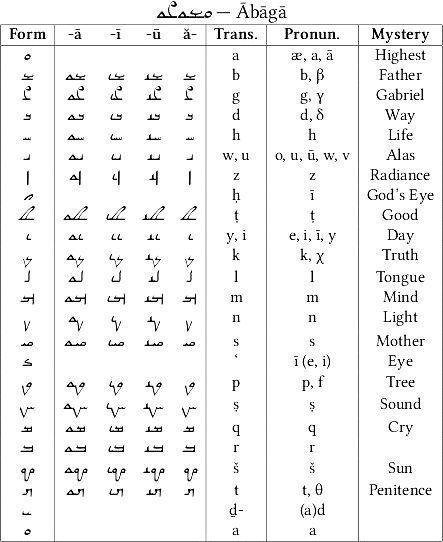Type Alphabet ISO 15924 Mand, 140 | Direction Right-to-left | |
 | ||
Languages Mandaic languageNeo-Mandaic Parent systems PhoenicianAramaicMandaic | ||
The Mandaic alphabet is based on the Aramaic alphabet, and is used for writing the Mandaic language. The Mandaic name for the script is Abagada or Abaga, after the first letters of the alphabet. Rather than the ancient Semitic names for the letters (alaph, beth, gimal), the letters are known as â, bâ, gâ and so on.
Contents
Characteristics
The alphabet consists of 24 letters: the 22 letters of the Aramaic alphabet (and in the same order), and then two additional letters at the end. As the number 24 is auspicious for Mandaeans (it is the number of hours from sunset to sunset), the additional letters are somewhat artificial. The 23rd letter is adu, the relative particle (cf. Arabic tāʾ marbūṭa, Coptic letter "ti", and English ampersand). The 24th is the first letter, a, repeated. Thus, Mandaeans say that the abagada has perfected the alpha and omega.
Unlike most other Semitic alphabets, the vowels are usually written out in full. The first and last letter, a (corresponding to alaph), is used to represent a range of open vowels. The sixth letter, wa, is used for close back vowels (u and o), and the tenth letter, ya is used for close front vowels (i and e). These last two can also serve as the consonants w/v and y. The eighth letter corresponds to the Semitic heth, and is called eh; it is pronounced as a long i-vowel but is rarely used as it is thought to be a sacred representation of the eye of God. A similar situation exists for the sixteenth letter, e (Aramaic ayn), which usually represents e at the beginning of a word or, when followed by wa or ya, represents initial u or i respectively.
All the letters in the Mandaic alphabet are considered by Mandaeans to have magic properties and impart mysteries (raze). A hint at a few of these meanings is given alongside the respective letters.
Postclassical and modern Mandaic uses a lot of Persian words. Four additional letters are used in writing nonclassical words.They are, in fact, simple modifications of the canonical letters and are not considered to bring the sum of letters to 28. The letters gha, dha, fa and ja are produced by placing two horizontally-aligned dots under ga, da, pa and sha, respectively. They can be compared to the four novel letters in the Persian alphabet, and the eighteen novel letters in the Sindhi alphabet.
Unicode
The Mandaic alphabet was added to the Unicode Standard in October, 2010 with the release of version 6.0.
The Unicode block for Mandaic is U+0840–U+085F:
